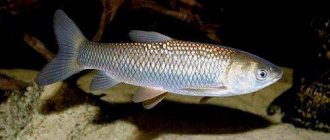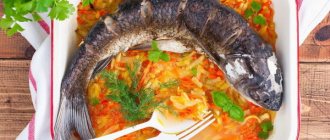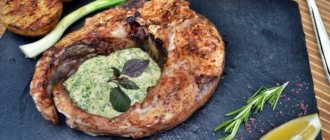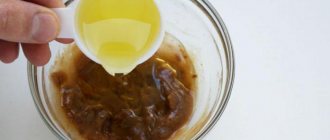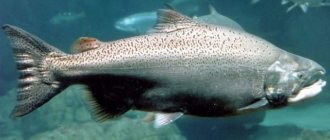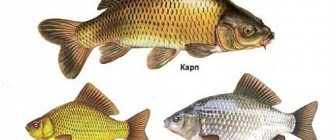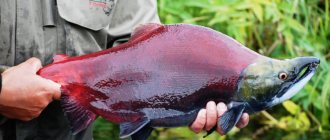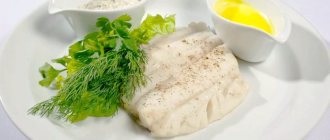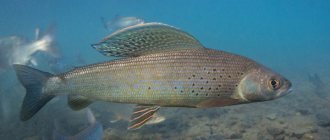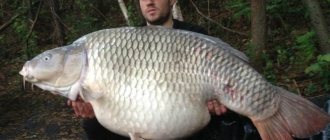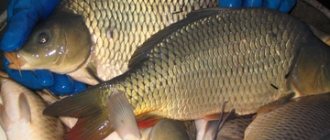Is grass carp bony?
Grass carp (Ctenopharyngodon idella) belongs to the carp family (Cyprinidae). It has an elongated cylindrical body with moderately large scales, a small head with a flattened forehead without scales. The scales give the fish a silver or olive color, but the belly remains light. The pectoral fins are located near the gill covers. The dorsal fin has three simple and seven branched rays.
Unlike carp, it does not have golden scales and does not have antennae above its upper lip. But in terms of the degree of bonyness, it is no different from other cyprinids, i.e., it is also bony. There is good news - this is one of the largest fish in the family with a maximum weight of up to 45 kg. Consequently, the bones of cupid are large and easy to remove. Therefore, we can conclude that its bonyness is not of great importance for cooking.
Did you know? The IGFA world record for catching grass carp was set in Bulgaria in 2009, where a specimen weighing 39.75 kg was caught.
Anatomical features of cupid
Grass carp has a cylindrical body, which is slightly flattened on the sides. Its shape is somewhat similar to a chub. His head seems to be an extension of his body. The mouth is of medium size. Its scales are quite large. All scales have a black frame around the edges. The dorsal fin is slightly rounded. It is located slightly closer to the ventral fins. The back and belly also have a rounded shape. There are from 40 to 50 scales on the side.
The pelvic fins are located slightly above the anus. The anal fin is small and also slightly rounded. The dorsal fin is quite developed. All fins, with the exception of the dorsal and caudal fins, have light shades. The caudal fin is quite developed. This is apparently connected with the active image of this representative of cyprinids.
The value of carp in nature
The individual belongs to the herbivorous fish of the carp family. This species grows very quickly, reaching large sizes. Fish is considered valuable in the commercial economy; it is loved for its special taste and enormous health benefits. The river inhabitant is the basis of a huge number of recipes for cold and hot dishes, salads and snacks.
In natural reservoirs, this fish is considered a cleaner. It lives mainly in rivers of Russia, in East Asian ponds , in the Amur and some rivers of China. The species was brought to the territory of the USSR for the purpose of further breeding in case of successful acclimatization. At first, scientists sounded the alarm, since the fish ate a huge amount of grass per day - more than it weighs. In some coastal villages, residents even throw cut grass into reservoirs, feeding river inhabitants.
This fish eats plants
It was the fact of eating vegetation that interested environmental safety advocates and energy workers, who had no idea what to do with silted cooling ponds at large industrial facilities.
In this video you will learn what harms fish:
https://youtube.com/watch?v=gfOI1o6FVno
Some algae that could not be removed by any means (for example, Elodea) were successfully destroyed and significantly reduced in volume thanks to grass carp.
Diet and nutrition of grass carps
Cupid feeds on algae, fresh reed shoots and plankton. In one day, an adult is able to eat up to 2 kg of vegetation. Therefore, the main condition for carp to live in sufficient quantities is the presence of a large food supply. The grass carp fish leads a fairly active lifestyle. Unlike tench, which is used to living in one quiet and peaceful place, cupid actively moves throughout the entire water area in search of food. It often appears in places with high currents, where the water is warmer. This feature of this fish became the reason for its appearance in closed cooling ponds of nuclear power plants. The water temperature in them is higher than in other rivers and lakes. Such conditions promote rapid metabolism. Very large specimens grow in such reservoirs.
Taste qualities
The taste of any carp, including grass carp, depends on what it ate. It absorbs pond algae, as well as:
- duckweed;
- grass;
- hornwort and reed;
- small crustaceans;
- leeches;
- insects;
- shellfish
If there is little vegetation in the pond, it can eat the eggs of smaller fish. Therefore, in artificial reservoirs it is fed with mown grass, reeds and feed mixtures for carp. Accordingly, fish from a pond that is regularly cleaned of organic residues will probably taste better than fish from a dirty one.
Usually people who report that the fish was not tasty simply cleaned and cooked it incorrectly. Cyprinids have many sharp, small bones throughout the fillet.
Therefore, when processing a carcass, follow these simple rules:
- Leave the caught live grass carp in clean water with ice for a day. Don't feed him anything. The fish is in active contact with the aquatic environment and during this time the water will draw out from the meat everything that it has accumulated during its residence in the reservoir. This is a very important step in cooking.
- You can also add salt to the water in moderation to speed up the cleaning process.
- If it is a carcass, then it is frozen in order to make sure there are no parasites, if there were any. It is believed that one-time freezing improves the taste of meat.
- When cutting a carcass, make cuts on the sides along the ribs, this helps soften the small bones that were contained in the fillet.
- Be sure to choose the perfect set of seasonings for yourself, since the taste of any fish is neutral and becomes more intense thanks to aromatic herbs.
You also need to remember that a larger fish is also an older one. This means she has more:
- dense texture;
- a more intense taste of meat, which is not always a bad thing.
Cupid is caught when it is young and weighs no more than 5 kg. Its meat will be more nutritious and contain a reduced content of heavy metal salts and other toxins that the fish accumulates during its life.
Did you know? Adult grass carp are caught on bread and dough. But the problem is that due to his vegetarian eating habits, it is very difficult to attract him to the bait.
Baking whole cupid in foil
For baking you need the following ingredients:
- Grass carp – 2-3 kg.
- Lemon – 1 pc.
- Garlic – 1 head.
- Onion – 1 head.
- Sunflower oil – 3 tbsp.
- Salt - to taste.
- Pepper - to taste.
- Bay leaf – 2 leaves.
How to cook grass carp in foil in the oven?
- First you need to prepare the fish carcass, gut it, peel it, remove the head and fins. Rinse well under running water, be sure to remove any remaining water with paper towels.
- Next, make transverse cuts on the sides of the fish, add salt and pepper. You also need to chop the garlic, rub the whole carcass with it, on all sides, also inside the abdomen.
- Peel the onion, cut into half rings of medium thickness, stuff them into the belly of the fish, along with bay leaves.
- Next, cut the lemon into halves of circles and insert them into the slots on the sides of the carp carcass.
- The stuffed fish should be placed on foil and wrapped tightly, preferably in several layers.
- Place the wrapped fish on a baking sheet and place in a preheated oven to a temperature of 180 ºC. Bake for 40 minutes, after which you need to take out the baking sheet and carefully unfold the foil. We send the dish back for another 10 minutes to form a beautiful golden crust.
Cooking meat according to this recipe will acquire a piquant taste with garlic aroma and a slight sourness of lemon. The recipe is not complicated and does not require any special culinary skills. Meat baked in this way remains healthy and retains a large amount of amino acids and vitamins. The dish can be served with almost all the side dishes; decorated with fresh vegetables and herbs, it will suit the festive table.
Fish habitat
This large species became popular in the middle of the last century, when Soviet scientists began to solve water management problems.
Underwater reclamation machines
In summer, reservoirs, lakes, canals and ponds are heavily overgrown with underwater and surface vegetation. The water “blooms”, becoming green. Excessive overgrowth leads to a decrease in the quality of drinking water, negatively affects the productivity of fish ponds, and electricity generation in the coolers of thermal power plants decreases.
The herbivorous grass carp and silver carp were involved in the fight against this phenomenon. By satiating themselves, peaceful vegetarian fish simultaneously effectively cleanse water bodies of excess herbaceous vegetation. The description of the properties of silver carp and the more massive carp has a lot in common - location, acclimatization, benefits.
Introduced from East Asia, the unpretentious carp cannot live in seawater. Now it is found in almost any fresh water body in Russia:
- in large rivers - Volga, Don, Ob and others;
- in reservoirs of hydroelectric power stations;
- in large bodies of water near thermal power plants;
- in lakes and ponds overgrown with reeds and duckweed.
Grass carp has adapted well to the difficult Russian climatic conditions and overwinters in a suspended state. They began to artificially propagate it in private pond farms.
Is grass carp bony?
Grass carp has a special place in Asian cuisine. Domestic chefs also pay attention to this fish. Therefore, the question of whether grass carp is bony or not is important - especially for novice cooks.
It would be wrong to say that cupid has few bones. No, like any fish of the cyprinid genus, grass carp has the same structure. But - no more, and no less. That is, during the cooking process there will be as much trouble with it as with ordinary carp.
And if you, as a culinary specialist, are interested in grass carp, bony or not, it doesn’t really matter. Moreover, dishes made from grass carp are so delicious!
Cooking grass carp
Grass carp is famous for its fatty white meat, as well as its large, delicious liver, which Eastern chefs love to cook - almost more often than the meat itself. Let's see how to cook grass carp fish
Most often, cupid is baked in foil or stewed with vegetables. Thus, one of the most popular dishes is cupid stuffed with eggplants and tomatoes, fried in a special grill on pear or cherry pits.
Not all housewives have the opportunity to cook on a grill, so let’s take a simpler recipe - cupid baked in foil.
Blackberries: beneficial properties and contraindications
The first varieties of blackberries were bred in America in the forties of the 19th century. By 1919, more than 20 thousand hectares of US agricultural land were allocated for the cultivation of this subshrub. Today the leader in blackberry production is Mexico. In Asia and Eastern Europe, this plant is cultivated mainly by amateur gardeners.
Blackberries are actively used in cooking. They are used to prepare syrups, compotes, fruit salads, jams, confectionery, baking fillings, fruit wines, liqueurs and liqueurs. The fruits, leaves, stems and roots of blackberries are used for medicinal purposes.
Calorie content of fish
Grass carp fits perfectly into any diet. It contains very few calories - only about 125 per 100 grams of product and very little fat. But if you cook it by frying, the volume of fat in the final dish increases.
Did you know? In one day, grass carp consumes as much vegetation as it weighs.
100 g of raw fish contains:
- protein - 17%, which is 79% of the carcass weight;
- fat - 2%, accounting for 21% of the total mass;
- carbohydrates - 0%.
Description, selection criteria
If the cupid was brought from afar, it is not fresh.
Carcasses are frozen before transport and then thawed before sale. The exception is special containers for storing fish products, but they are very expensive, so they are rarely purchased in stores.
Fish can be raised in artificial reservoirs , where they are fattened specifically for sale. This grass carp can be fed with various supplements to help it grow faster. This may negatively affect its quality. Try to purchase products from trusted places.
Also, you should not buy promotional goods, since these promotions are mainly organized so that the products do not disappear.
Another point is the scales. It is important that it is not faded and that the fins are not withered. Cupid doesn't last long - it is more susceptible to spoilage than meat and seafood. Therefore, after buying fish, it is better to cook it immediately or freeze it.
But you shouldn’t freeze it more than once , as all the beneficial properties will be lost.
How to choose and how to store
The product can be found both in a regular store and at the grocery market. But choosing a quality product is quite difficult. Usually the carcasses of adult, medium-sized fish are chosen. Then the meat will be better separated from the bones.
You need to smell it before buying. The carcass should not smell like mud. If the scales are dull, the product has probably been stored for a long time. The fins of grass carp must be elastic.
Grass carp must be stored correctly. Fish fillets cannot be stored for a long time. The semi-finished product can be left in the refrigerator, but for no more than two days. Once frozen, the product can be stored in the freezer for up to two months.
However, before cooking, it is completely defrosted. This way you can evaluate the appearance of the fish and its condition. If there is a suspicion that the meat is spoiled, it is better to dispose of it to avoid poisoning. Repeated freezing of grass carp is unacceptable.
Very tasty baked whole carp
Taste qualities
Due to the fact that the fish follows a “vegetarian” diet, its meat is creamy white in color and has an excellent taste. It is juicy, fatty and nutritious. In terms of taste, carp meat is superior to carp and silver carp meat, as it has a more delicate and sweetish taste. In addition, it does not emit the smell of mud and silt like other river fish.
Grass carp meat is inferior in taste to carp and catfish. But thanks to its more neutral taste, it can be given different flavors with the help of spices.
Description of the White Amur fish
Grass carp is one of the largest representatives of cyprinids. Initially, this fish was found in the waters of East Asia. Nowadays, carp are actively populated in bets and artificial reservoirs.
Fish is considered valuable because of its fatty and tasty meat. In terms of gastronomic qualities, it is not inferior to carp meat. The main factor influencing taste is the environment. If the reservoir has running water, springs, and is not silted everywhere, then cupid dishes will be very tasty.
The value of this fish is that it grows very quickly. Active eating of algae contributes to rapid weight gain. In terms of growth rate, carp is not inferior to carp and silver carp. In one year, carp grows by 10 cm. Large individuals reach a mass of 30 kg and a length of over 1 meter. Such features of the fish make it desirable for fishermen. Fishing for grass carp is just as exciting as carp fishing.
Cupid is a very hardy fish. It tolerates warm water (up to 35 degrees). The carp stops feeding when the water temperature drops below 10 degrees. Cupid lives not only in fresh water bodies. In reservoirs with a salt content of up to 22 grams per liter, it feels quite good.
Beneficial features
Grass carp is useful for improving the functioning of the cardiovascular system, minimizing inflammatory processes in the body, and optimizing the functioning of the digestive organs.
Fish is rich in minerals and vitamins, especially phosphorus and vitamin B 12, which the body needs to function properly, and is also high in healthy fatty acids, proteins and antioxidants. Therefore, cupid is useful as a source of dietary nutrition.
100 g of product contains:
| Minerals (in mg): | Vitamins and other substances (in mg): |
|
|
High levels of Omega-3 fatty acids can protect the heart, reduce the risk of atherosclerosis, normalize blood pressure, relieve stress on the cardiovascular system and reduce the likelihood of a heart attack or stroke.
If you regularly suffer from joint pain, doctors and nutritionists suggest increasing your weekly fish intake. This will reduce inflammation and help treat rheumatoid arthritis.
The zinc found in fish is a key element in stimulating the immune system, and grass carp is rich in zinc, which contains 10% of the daily value. Phosphorus is found in all cyprinids in extremely high concentrations - 50% of the daily requirement. This macronutrient is very important for strengthening bone tissue and maintaining healthy teeth.
Commercial value
Numerous fish farms are engaged in breeding silver carp. They get along well with other fish, reach large sizes, and also help keep the pond clean, playing the role of natural orderlies. Such breeding is considered very profitable, especially in industrial quantities. The presence of silver carp in a stocked reservoir almost doubles fish productivity.
Silver carp meat is full of nutrients . True, it is inferior in taste to grass carp meat. Silver carp can be consumed even with a gentle diet during diseases of the gastrointestinal tract. The main benefit lies in the rich content of omega-3 and omega-6 polyunsaturated fatty acids. These substances help in the functioning of the cardiovascular system, the development of immunity, as well as the preservation of the natural beauty and youth of the body. Meat rich in minerals and vitamins promotes the production of hemoglobin, enhancing the antioxidant effect on the body.
Silver carp is a unique fish for dietary nutrition for those who want to lose weight. During thermal cooking, it loses some of its calorie content. 100g of the finished product contains approximately 78 calories. Silver carp is rich in protein, and the composition of its fat is similar to the composition of the fat of sea fish. Dishes made from this type of fish are appreciated by people suffering from diabetes. Their frequent use helps reduce blood sugar levels.
Important! This type of fish can carry parasites that cause metagonimiasis when ingested by humans. They look like worms with small spines, 1 mm in size, which successfully take root in the intestines.
When infected and as they develop in the intestine, damage occurs to its mucous membrane. As a result, abdominal pain, diarrhea, nausea and vomiting appear. Without medical intervention, the infection can progress in the intestines for up to 1 year.
Return to content
simple-fauna.ru
Comments to White Cupid
In order to leave a comment, you need to register or log in to the site.
Latest articleslatest commentscomment to Matsoni 12/26/2016 15:42 |
As for me, matsoni is a universal product. It is good for losing weight and improving overall well-being. In addition, it is good as a snack, or a late dinner. Moreover, it is very tasty. Only I cook it with a special sourdough starter, it is so and it’s called Matsoni (I buy BakZdrav), I mix it with warm, but not hot milk and put it in a slow cooker for 8 hours. After that, I put the almost finished matsoni in the refrigerator for 2 hours. And then you can enjoy this drink)
| commentary on Verrukacid 12/11/2016 20:37 If someone needs to remove a wart or get rid of papillomas, then they can without a doubt use verrukacid. It does not leave marks on the site of a shrunken wart and acts quickly. You can use it at home, on your own. |
| comment on Dibikor 11/25/2016 16:56 Good drug, well tolerated, improves health. I took dibicor to lower my cholesterol to normal. The first time I managed to do this without statins, but the doctor advised me not to relax and to continue to stick to the diet. I plan to follow the doctor’s recommendations; I don’t want any more problems with excess weight and blood vessels. |
| comment to Alflutop 10/22/2016 10:32 pm Elbon’s money, of course, is much more profitable. Alflutop is expensive, apparently due to animal origin. |
| comment to Valoserdin 10.20.2016 18:29 I see that Valoserdin has helped many here. Well, I will speak out in his favor. I won’t bore you with my stories and details. In general, I thought that I could cope with causeless anxiety and insomnia on my own. But no, I had to go to the pharmacy. There I learned about Valoserdin. He helped me then, and he helps me now. Now, thank God, I won’t go hysterical like a woman. |
Fishing for grass carp
Catching grass carp in summer is not an easy task, since this representative of carp feeds exclusively on aquatic vegetation, which grows in large quantities in summer. In addition, he is very timid and at the slightest danger he even moves away from feeding areas.
In cases where the desire to catch a river cow exceeds common sense.
They resort to the following methods.
The weather should be warm and calm, the water temperature should be at least 18 degrees. Gear is selected based on the characteristics of the reservoir. The best option is a plug, then a feeder, a match rod.
Plug
- To catch a large specimen, use poles of at least 13 meters. The rubber shock absorber selects, depending on the thickness of the fishing line, 1.4 - 0.14, 1.6-0.16, 1.8-0.18, etc. Hook No. 10 is knitted directly to the fishing line. This rule applies to any fishing method. In order not to spook the fish, the bait is lowered slightly to the side of the baited area and throughout the entire fishing, move it slightly, swinging the rod.
Feeder
- A special feature of fishing with feeder gear is a floating paternoster feeder inside, into which foam plastic is inserted to hold it on the surface of the water. The food is slowly washed out, attracting fish in a column of turbidity. Feeder gear uses braided line, which will allow you to catch large fish.
Match rod
- A match rod is excellent for fishing for grass carp if you equip it with a reliable reel and braid with a diameter of 0.5 mm. Hooks for the match are selected No. 2-4 according to M.K.
Nozzle
For bait, you can use traditional bait: cucumber cubes, dandelion stem, cabbage leaf, bean or pea pods. Cupid loves tiger nut very much. Currently, they are successfully caught using boilies, pickled corn, and steamed wheat.
If juveniles can also bite on a worm, then a large specimen can be caught exclusively with plant bait. Before attaching, cut the cucumber into small cubes, take bean pods and peas that are not hard with barely emerging grains.
Cabbage
The cabbage leaf is taken closer to the middle and cut into strips along the vein of the leaf. Place an accordion on the hook, leaving a small 5 cm hanging tail. What’s good about catching carp is that once you get to a body of water without bait, you can use ordinary aquatic vegetation on which it feeds, and its appetite is excellent: 1 kg per 2 kg of fish weight.
Reed
Young shoots of reeds are also excellent. To catch grass carp on reeds, you need to know how to bait it correctly.
A bunch - several leaves 7-12 cm in a quantity of 6-10 pieces, tied into a bunch with another leaf. The bundle is placed on the hook so that the sting points outward. Accordion - the sheet is rolled into an accordion with a side of 2.5-3 cm and put on the hook with the tip facing out. The length of the folded sheet on a hook with a leash is 7-10 cm.
The reed leaf should look like one that has just fallen from a branch and floating on the surface of the water. To impart buoyancy, use a small foam ball tied at a distance of 8-11 cm from the bait.
The best time of year for catching grass carp is considered to be the autumn months of September and October, until the water cools below 12 degrees and the fish go to wintering pits.
What grass carp bite on in the fall.
So, with the onset of cold weather, the grass settles, the food supply becomes scarce, and the fish are more willing to take the bait offered by the fisherman, which are also used in summer fishing. In essence, autumn fishing differs from summer fishing only in the search for fish. In the fall, it is alleviated by the fact that the fish begins to abundantly secrete mucus, which floats in threads on the surface of the water, revealing the location of the object of hunting.
Lure
The voracious river cow is very fond of abundant bait, for which they take grain corn as bait, or crushed, boiled and mixed with coriander.
Corn baits are prepared as follows. Porridge is made from 1 kg of corn or coarsely ground grain. A 10-15g bag of coriander is added to the hot porridge, everything is mixed and the pan is wrapped in a blanket for about five hours for steaming. During fishing, the porridge is simply scattered over a decent area at the place where the gear is installed. You can add pearl barley, overripe bananas, and honey for sweetness and aroma.
Fishing technique and tactics
Belamur feeds non-stop from early morning until late evening. But it’s better to catch it in the first half of the day, when the fish are as hungry as possible. To avoid spooking the prey with unnecessary noise and movements, a long cast is required. If the school is close to the shore, the angler takes a position to the side and casts the bait diagonally. But fishing from the opposite shore is especially popular.
To learn more:
Description of bluefish fish: habitats and fishing methods
You should not throw in bait at the very beginning of fishing, which, falling into the water, can scare away the peacefully feeding fish. You should create a bait cloud of turbidity only when there has not been a single bite for an hour or an hour and a half. Sometimes it is advisable to attach several promising places at once, and start fishing in a calmly unfed area.
When to hook and how to fish out
The hooking time depends on the type of nozzle. If there is a bunch of greenery or a piece of cabbage leaf on the hook, you need to wait for the tip of the feeder or float to constantly tremble and make a sharp and strong swing of the rod. With compact baits (boilie, crawler, corn), grass carp does not stand on ceremony, immediately grabs it and tries to stroke it. In such a situation, an immediate hook is required as soon as the bite alarm goes off.
Fishing for grass carp requires maximum concentration. He will definitely show strong resistance and try to hide in aquatic vegetation. Quite often, the fish meekly follows to the shore, creating a misleading impression of its size. But at some point it makes a powerful jerk, and if the clutch on the reel is not loosened, a breakdown follows.
